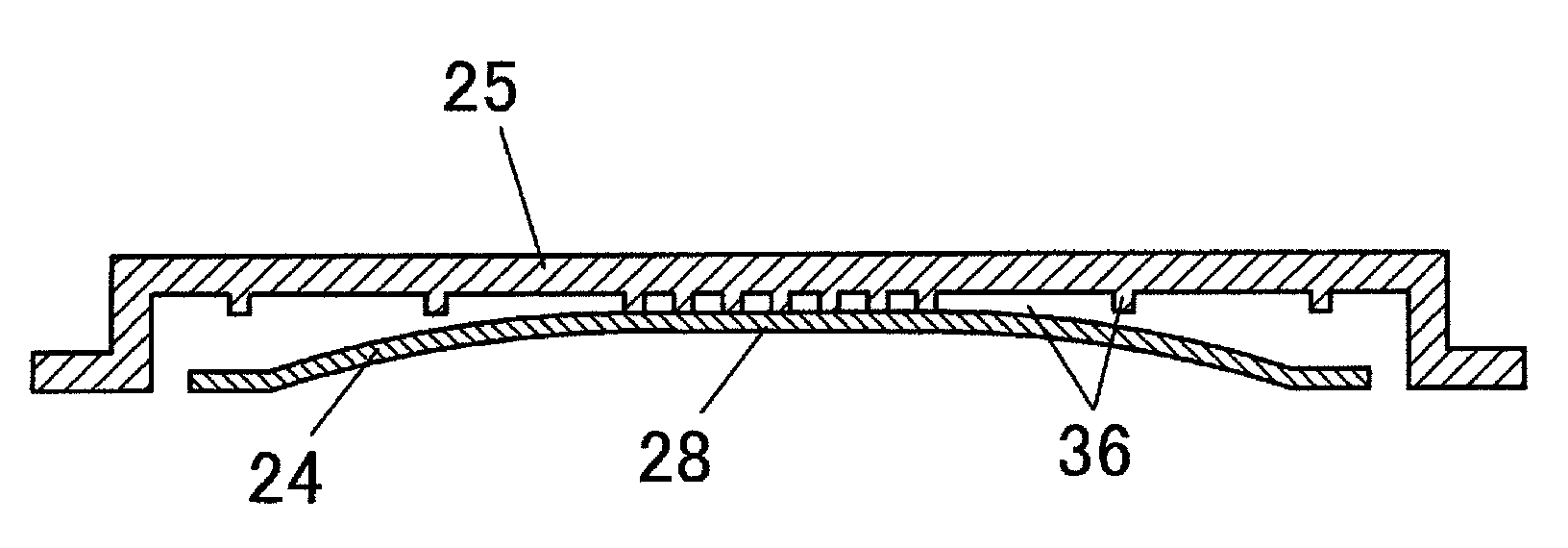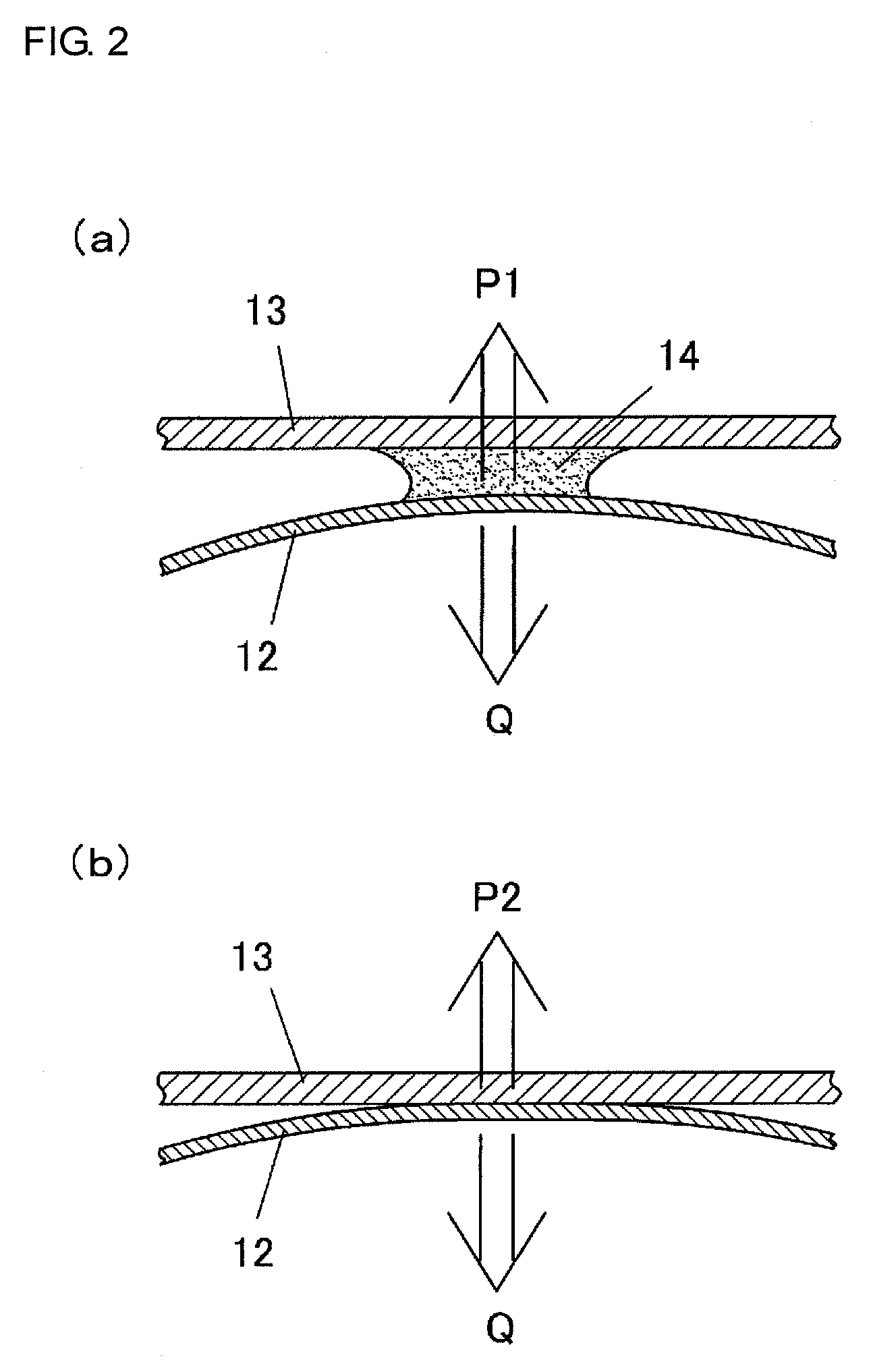Acoustic sensor
a technology of acoustic sensor and electrode plate, which is applied in the field of acoustic sensor, can solve the problems of deformation of sensitivity of acoustic sensor b>11/b>, hard vibration, and low sensitivity of acoustic sensor, so as to reduce local sticking, reduce the whole sticking of vibrating electrode plate, and avoid uneven and efficient effects
- Summary
- Abstract
- Description
- Claims
- Application Information
AI Technical Summary
Benefits of technology
Problems solved by technology
Method used
Image
Examples
first embodiment
[0081]A first embodiment of the invention will be described with reference to FIGS. 5 to 13. FIG. 5 is a perspective view illustrating an acoustic sensor 21 according to the first embodiment of the invention, FIG. 6 is an exploded perspective view thereof, and FIG. 7 is a sectional view taken on a line Y-Y of FIG. 5.
[0082]The acoustic sensor 21 is of a capacitance type. In the acoustic sensor 21, a vibrating electrode plate 24 is provided on an upper surface of a silicon substrate 22 with an insulating coating 23 interposed therebetween, and a counter electrode plate 25 is provided on the vibrating electrode plate 24 with a micro gap (air gap) interposed therebetween.
[0083]A prismatic through-hole 26 or a truncated-pyramid recess is provided in the silicon substrate 22. The prismatic through-hole26 is illustrated in the drawing. The silicon substrate 22 has a size of 1 to 1.5 mm square (can be formed smaller than this size) in a planar view, and the silicon substrate 22 has a thickn...
second embodiment
[0105]An acoustic sensor according to a second embodiment will be described with reference to FIGS. 14 to 17. Because a structure of the acoustic sensor according to the second embodiment is substantially similar to the structure of the acoustic sensor 21 according to the first embodiment, the entire structure and description thereof are not provided.
[0106]The acoustic sensor of the second embodiment differs mainly from the acoustic sensor of the first embodiment in the shape of the vibrating electrode plate 24 and the arrangement of the projections 36. These different points will be described below.
[0107]FIG. 14 is a view illustrating a positional relationship among the vibrating electrode plate 24, the acoustic perforations 31, and the projections 36 in the second embodiment, when viewed from a direction perpendicular to the vibrating electrode plate 24. The vibrating electrode plate 24 has a circular disc shape, and a cylindrical through-hole or a truncated-cone recess is provide...
third embodiment
[0113]FIG. 18 is a view illustrating a positional relationship among the vibrating electrode plate 24, the acoustic perforations 31, and the projections 36, according to a third embodiment, when viewed from a direction perpendicular to the vibrating electrode plate 24. FIG. 19 is a partially enlarged view illustrating the counter electrode plate 25 according to the third embodiment. In this embodiment, the projections 36 are brought close to the acoustic perforations 31 or are brought into contact with the acoustic perforations 31.
[0114]In the first and second embodiments, as illustrated in FIG. 21, the projection 36 is provided in the center of the region surrounded by the acoustic perforations 31. Therefore, the projection 36 is located far away from any of the acoustic perforations 31. When water 37 invading into the micro gap between the vibrating electrode plate 24 and the counter electrode plate 25 evaporates from the acoustic perforations 31, the water 37 remains last at the ...
PUM
 Login to View More
Login to View More Abstract
Description
Claims
Application Information
 Login to View More
Login to View More - R&D
- Intellectual Property
- Life Sciences
- Materials
- Tech Scout
- Unparalleled Data Quality
- Higher Quality Content
- 60% Fewer Hallucinations
Browse by: Latest US Patents, China's latest patents, Technical Efficacy Thesaurus, Application Domain, Technology Topic, Popular Technical Reports.
© 2025 PatSnap. All rights reserved.Legal|Privacy policy|Modern Slavery Act Transparency Statement|Sitemap|About US| Contact US: help@patsnap.com



